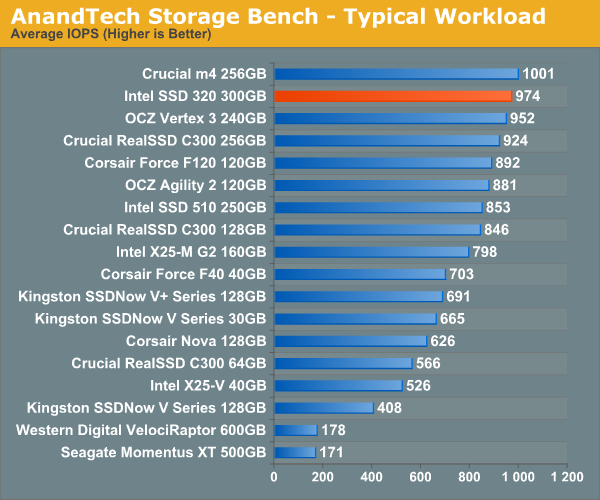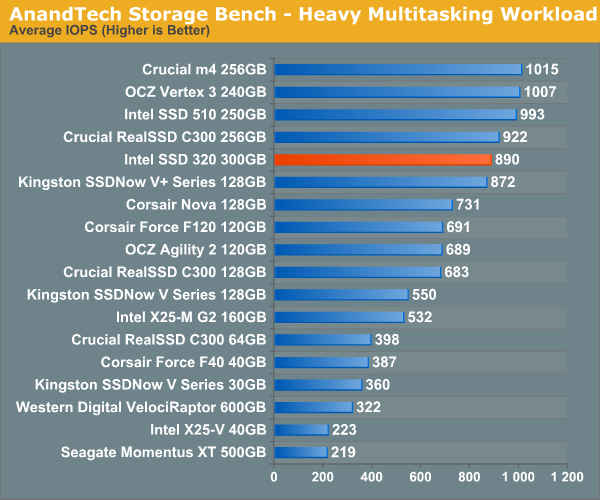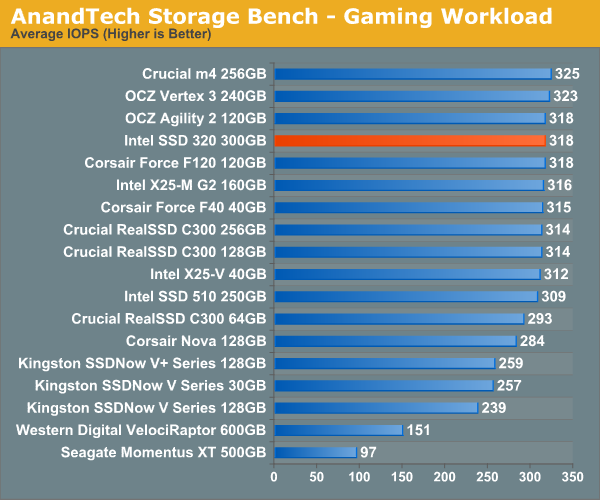The Intel SSD 320 Review: 25nm G3 is Finally Here
by Anand Lal Shimpi on March 28, 2011 11:08 AM EST- Posted in
- IT Computing
- Storage
- SSDs
- Intel
- Intel SSD 320
AnandTech Storage Bench 2010
To keep things consistent we've also included our older Storage Bench. Note that the old storage test system doesn't have a SATA 6Gbps controller, so we only have one result for the 6Gbps drives.
The first in our benchmark suite is a light/typical usage case. The Windows 7 system is loaded with Firefox, Office 2007 and Adobe Reader among other applications. With Firefox we browse web pages like Facebook, AnandTech, Digg and other sites. Outlook is also running and we use it to check emails, create and send a message with a PDF attachment. Adobe Reader is used to view some PDFs. Excel 2007 is used to create a spreadsheet, graphs and save the document. The same goes for Word 2007. We open and step through a presentation in PowerPoint 2007 received as an email attachment before saving it to the desktop. Finally we watch a bit of a Firefly episode in Windows Media Player 11.
There’s some level of multitasking going on here but it’s not unreasonable by any means. Generally the application tasks proceed linearly, with the exception of things like web browsing which may happen in between one of the other tasks.
The recording is played back on all of our drives here today. Remember that we’re isolating disk performance, all we’re doing is playing back every single disk access that happened in that ~5 minute period of usage. The light workload is composed of 37,501 reads and 20,268 writes. Over 30% of the IOs are 4KB, 11% are 16KB, 22% are 32KB and approximately 13% are 64KB in size. Less than 30% of the operations are absolutely sequential in nature. Average queue depth is 6.09 IOs.
The performance results are reported in average I/O Operations per Second (IOPS):

If we strip 6Gbps out of the equation completely, the SSD 320 does very well in our old light workload. You're looking at performance that's at the top of the pack from the mainstream offering.
If there’s a light usage case there’s bound to be a heavy one. In this test we have Microsoft Security Essentials running in the background with real time virus scanning enabled. We also perform a quick scan in the middle of the test. Firefox, Outlook, Excel, Word and Powerpoint are all used the same as they were in the light test. We add Photoshop CS4 to the mix, opening a bunch of 12MP images, editing them, then saving them as highly compressed JPGs for web publishing. Windows 7’s picture viewer is used to view a bunch of pictures on the hard drive. We use 7-zip to create and extract .7z archives. Downloading is also prominently featured in our heavy test; we download large files from the Internet during portions of the benchmark, as well as use uTorrent to grab a couple of torrents. Some of the applications in use are installed during the benchmark, Windows updates are also installed. Towards the end of the test we launch World of Warcraft, play for a few minutes, then delete the folder. This test also takes into account all of the disk accesses that happen while the OS is booting.
The benchmark is 22 minutes long and it consists of 128,895 read operations and 72,411 write operations. Roughly 44% of all IOs were sequential. Approximately 30% of all accesses were 4KB in size, 12% were 16KB in size, 14% were 32KB and 20% were 64KB. Average queue depth was 3.59.

Crank up the workload and the 320 falls a bit behind the rest of the competitors. Last year's heavy multitasking workload is nothing compared to what we introduced earlier this year, so it's still pretty light by comparison but it's clear for normal usage the 320's 3Gbps performance is quite good.
The gaming workload is made up of 75,206 read operations and only 4,592 write operations. Only 20% of the accesses are 4KB in size, nearly 40% are 64KB and 20% are 32KB. A whopping 69% of the IOs are sequential, meaning this is predominantly a sequential read benchmark. The average queue depth is 7.76 IOs.











194 Comments
View All Comments
semo - Monday, March 28, 2011 - link
Anand, it has been a long time now. People are still confused about what is happening with the OCZ V2 drives. OCZ are still not issuing a recall of drives that are smaller and slower than what the packaging claims.OCZ will only react when the customer finds out through their own research what has happened and then confronts OCZ.
For those wanting to know more, see my thread below or research the OCZ Vertex 2 25nm transition fiasco.
http://forums.anandtech.com/showthread.php?t=21433...
The issue will not be resolved until OCZ recalls all affected products.
GeorgeH - Monday, March 28, 2011 - link
It looks like the crucial parts are physically identical to G2 drives. Intel may not offer updated firmware for G2 drives, but it looks like it might not be impossibly difficult to modify G3 firmware to work on G2 drives.Did Intel give any indication if the G2 controllers were physically different from the G3s? In other words did Intel take the laser scalpel to the G2 controllers or is it just a software restriction?
Chloiber - Monday, March 28, 2011 - link
Anand explained why the write performance is higher (4kB -> 8kB).GeorgeH - Monday, March 28, 2011 - link
Sure, but full disk encryption might be nice.Anand Lal Shimpi - Monday, March 28, 2011 - link
The G2 controller had the same features as the 320's controller. It's unclear whether they were tested/functional in the G2 era but they were there. The 320's controller is apparently the same physical die, just with these new features enabled/tested/validated.G1 owners didn't get TRIM, and I wouldn't expect G2 owners to get AES-128 via firmware. Sorry :(
bbbcase - Monday, March 28, 2011 - link
The Intel G1/G2 drives would eventually throttle write performance if you consistently wrote over 20GB/day on them to ensure warranty lifetime. This really limited their usefulness in certain server applications.Does the G3 have a similar throttling mechanism?
Chloiber - Monday, March 28, 2011 - link
?? They didn't. The block fragmentation will, in spite of TRIM increase (that's the case with pretty much every SSD). Write 0s sequentially on the empty space every 2 months and the performance will always be as it was on the first day.You can also do this by doing a Full Diagnostics Scan using the Intel SSD Toolbox (writes sequentially on the empty space).
toyotabedzrock - Monday, March 28, 2011 - link
I'm curious if a 8KB random R/W test would show a bump in speed beyond what other drives would see.Intel really needs to get serious about allocating people to the SSD and Chipset teams. They always make a quick leap with a great new chip then it languishes for years with minor updates.
Pentium 4 flashbacks!
cdbob - Monday, March 28, 2011 - link
I heard rumors that pricing was going to be on the steep side. It's too bad this turned out to be true, Intel better lower the price of their drives quick or they're going to start eating some serious dust when the next crop of Crucial Drives come out.Beenthere - Monday, March 28, 2011 - link
That's why I won't buy any SSD for at least five more years. Poor reliability and data loss don't work for me.